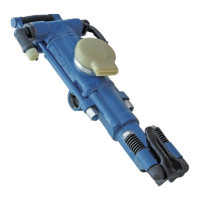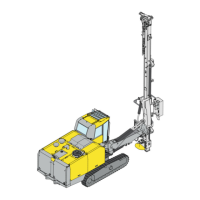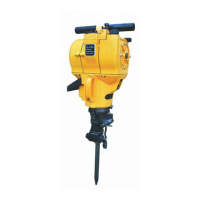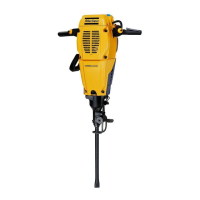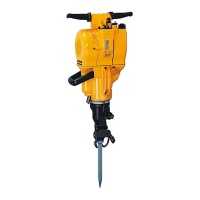clothing, and body parts. Examples of controls
include: exhaust ventilation and dust collection
systems, water sprays, and wet drilling. Control
dusts and fumes at the source where possible.
Make sure that controls are properly installed,
maintained and correctly used.
►
Wear, maintain and correctly use respiratory
protection as instructed by your employer and
as required by occupational health and safety
regulations. The respiratory protection must be
effective for the type of substance at issue (and
if applicable, approved by relevant
governmental authority).
►
Work in a well ventilated area.
►
If the machine has an exhaust, direct the
exhaust so as to reduce disturbance of dust in a
dust filled environment.
►
Operate and maintain the machine as
recommended in the operating and safety
instructions.
►
Select, maintain and replace consumables/
insertion tools/ other accessories as
recommended in the operating and safety
instructions. Incorrect selection or lack of
maintenance of consumables/ inserted tools/
other accessories may cause an unnecessary
increase in dust or fumes.
►
Wear washable or disposable protective clothes
at the worksite, and shower and change into
clean clothes before leaving the worksite to
reduce exposure of dust and fumes to yourself,
other persons, cars, homes, and other areas.
►
Avoid eating, drinking, and using tobacco
products in areas where there is dust or fumes.
►
Wash your hands and face thoroughly as soon
as possible upon leaving the exposure area,
and always before eating, drinking, using
tobacco products, or making contact with other
persons.
►
Comply with all applicable laws and regulations,
including occupational health and safety
regulations.
►
Participate in air monitoring, medical
examination programs, and health and safety
training programs provided by your employer or
trade organizations and in accordance with
occupational health and safety regulations and
recommendations. Consult with physicians
experienced with relevant occupational
medicine.
►
Work with your employer and trade organization
to reduce dust and fume exposure at the
worksite and to reduce the risks. Effective
health and safety programs, policies and
procedures for protecting workers and others
against harmful exposure to dust and fumes
should be established and implemented based
on advice from health and safety experts.
Consult with experts.
►
Residues of hazardous substances on the
machine can be a risk. Before undertaking any
maintenance on the machine, clean it
thoroughly.
WARNING Projectiles
Failure of the work piece, of accessories, or even
of the machine itself may generate high velocity
projectiles. During operating, splinters or other
particles from the working material may become
projectiles and cause personal injury by striking the
operator or other persons. To reduce these risk:
►
Use approved personal protective equipment
and safety helmet, including impact resistant
eye protection with side protection.
►
Make sure that no unauthorised persons
trespass into the working zone.
►
Keep the workplace free from foreign objects.
►
Ensure that the work piece is securely fixed.
WARNING Splinters hazard
Using the insertion tool as a hand struck tool can
result in splinters hitting the operator and can
cause personal injury.
►
Never use an insertion tool as a hand struck
tool. They are specifically designed and heat-
treated to be used only in a machine.
WARNING Slipping, tripping and falling
hazards
There is a risk of slipping, tripping or falling, for
example tripping on hoses or on other objects.
Slipping, tripping or falling can cause injury. To
reduce this risk:
►
Always make sure that no hose or other object
is in your way or in any other person's way.
►
Always make sure you are in a stable position
with your feet as far apart as your shoulder
width and keeping a balanced body weight.
WARNING Motion hazards
When using the machine to perform work-related
activities, you may experience discomfort in the
hands, arms, shoulders, neck, or other parts of the
body.
►
Adopt a comfortable posture while maintaining
secure footing and avoiding awkward off-
balanced postures.
Safety and operating instructions SRD 20, 25
8 © Construction Tools PC AB | 9800 1883 01 | 2017-05-31
Original instructions

